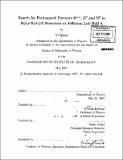Search for pentaquark partners [Theta]⁺⁺, [Sigma]⁰ and N⁰ in H (e,e'K [pi])) X reactions at Jefferson Lab Hall A
Author(s)
Qiang, Yi, Ph. D. Massachusetts Institute of Technology
DownloadFull printable version (48.97Mb)
Other Contributors
Massachusetts Institute of Technology. Dept. of Physics.
Advisor
William Bertozzi and Shalev Gilad.
Terms of use
Metadata
Show full item recordAbstract
In 1997, D. Diakonov et al. using a soliton model predicted a SU(3)F flavor antide-cuplet of pentaquarks. The most striking prediction using this symmetry group is a narrow exotic state, E+(1540), which has quark component uuddg. If such a state is confirmed, other members of the antide cuplet could be expected to have sufficiently narrow widths to be observed as well. The Jefferson Laboratory experiment E04-012 focused on the search for EO and NO partner states in the missing mass spectra of the H(e,e'K+)X and H(e,e'ir+)X channels. In addition, if the 8+ has non-zero isospin then a hypothetical isospin partner, O++, might be expected in the H(e,e'K-)X channel; this was also investigated. The experiment was performed in Hall A at Jefferson Lab using a 5 GeV electron beam incident on a liquid hydrogen target. The two high resolution magnetic spectrometers were coupled to septum magnets to allow measurement of scattered electrons and outgoing hadrons at angles as small as 6 degrees. The missing mass resolution was determined to be 3.5 MeV/c2 FWHM using neutron, A(1116) and E(1193) production and provided a high sensitivity to narrow resonances. A precise measurement of the A(1520) resonance has also been conducted for a cross-section comparison. As a result, no significant narrow resonances were observed in any of the three reaction channels being investigated. Based on this fact, a likelihood scan using the G. Feldman and R. Cousins method was performed. The analysis provided total cross section upper limits at 90% confidence level with no lower limits or always below background fluctuation.
Description
In title on t.p., "[Theta]", "[Sigma]", and "[pi]" appear as Greek letters. Thesis (Ph. D.)--Massachusetts Institute of Technology, Dept. of Physics, 2007. Includes bibliographical references (p. 169-175).
Date issued
2007Department
Massachusetts Institute of Technology. Department of PhysicsPublisher
Massachusetts Institute of Technology
Keywords
Physics.